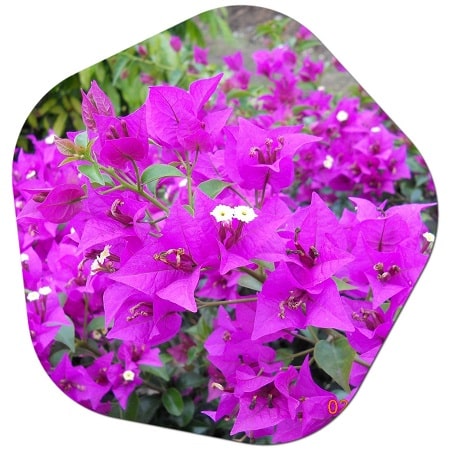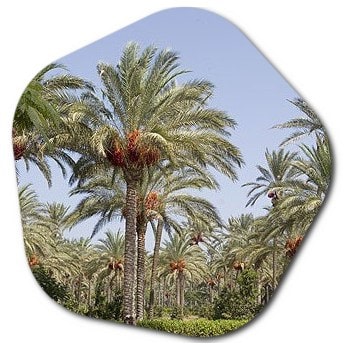These plants and flowers contribute to Dubai’s vibrant landscaping and green spaces, enhancing the city’s aesthetic appeal despite its challenging desert climate. Additionally, many of these plants have cultural and economic significance in the region.
Dubai, with its desert climate and arid conditions, presents some challenges for traditional flower cultivation. However, with the help of advanced irrigation and landscaping techniques, a variety of flowers can be grown in the city and its surrounding areas. Some of the flowers that you can find in Dubai include:
- Bougainvillea (Bougainvillea spp.): Bougainvillea is a popular flowering plant known for its vibrant and colorful bracts. It is often used in landscaping throughout Dubai due to its tolerance for the hot and dry climate.
- Hibiscus (Hibiscus spp.): Hibiscus plants are commonly cultivated in Dubai, and they produce large, showy, and colorful flowers.
- Desert Rose (Adenium obesum): The desert rose is well-suited to the arid conditions of Dubai. It features striking, trumpet-shaped flowers and thick, succulent stems.
- Poinciana (Delonix regia): The Royal Poinciana or Flamboyant tree is known for its bright red or orange flowers. It is a common sight in Dubai’s parks and along streets.
- Petunias (Petunia spp.): These colorful and hardy annuals are often used in flower beds and hanging baskets throughout the city.
- Plumbago (Plumbago auriculata): Plumbago produces clusters of blue or white flowers and is well-suited to Dubai’s climate.
- Portulaca (Portulaca grandiflora): Portulaca is a drought-tolerant plant that thrives in hot and sunny conditions, making it a good choice for Dubai’s climate.
- Lantana (Lantana camara): Lantana is known for its clusters of small, tubular flowers in a variety of colors and is often used in Dubai’s gardens and landscaping.
- Aloe Vera (Aloe barbadensis miller): While not primarily grown for its flowers, Aloe Vera is a common succulent in Dubai, appreciated for its medicinal properties and its occasional yellow or orange blooms.
- Agapanthus (Agapanthus africanus): Agapanthus, also known as Lily of the Nile, is sometimes used in Dubai’s landscaping and produces attractive globes of blue or white flowers.

Dubai’s municipal authorities and landscapers have made significant efforts to create and maintain lush and green environments in the city despite its desert surroundings. These flowers, along with a variety of other plants, are carefully selected and cultivated to enhance the city’s aesthetic appeal and provide green spaces for residents and visitors.
What plants are native to Dubai?
Dubai’s natural environment is largely desert, and as a result, native plants have adapted to thrive in arid and harsh conditions. While the desert landscape may not be as lush as more temperate regions, it still supports a variety of native plants that have evolved to survive in this environment. Some of the native plants to the Dubai region include:
- Date Palm (Phoenix dactylifera): The date palm is one of the most iconic and economically important native plants in the region. It has been cultivated for thousands of years for its delicious and nutritious fruit.
- Arabian Jasmine (Jasminum sambac): Arabian Jasmine is a fragrant flowering plant with white, star-shaped flowers. It is commonly grown in gardens and used in traditional perfumes.
- Zygophyllum simplex: This native shrub is well adapted to desert conditions and has tiny green leaves and small yellow flowers. It is often used in landscaping.
- Prosopis cineraria (Ghaf Tree): The Ghaf tree is considered the national tree of the United Arab Emirates. It is a hardy desert tree with small green leaves and produces yellow flowers.
- Calligonum comosum (Arfaj): Arfaj is a native shrub that can thrive in extremely arid environments. It has small pink or white flowers and is an important plant for stabilizing sand dunes.
- Rhanterium epapposum (Hammada): Hammada is a drought-resistant desert shrub with tiny, yellow flowers. It is well adapted to sandy and arid conditions.
- Euphorbia larica (Desert Spurge): This succulent plant has fleshy stems and produces small yellow flowers. It is well-suited to desert environments.
- Leptadenia pyrotechnica (Jaljala): Jaljala is a native plant that grows in arid regions and has green leaves with small pink or white flowers.
- Salsola cyclophylla (Samr): Samr is a small desert shrub with greenish-white stems and tiny green flowers. It is a common native plant in desert areas.
- Blepharis ciliaris (Blue Witch): Blue Witch is a small, hardy desert plant with blue or purple flowers.

These native plants have adapted to Dubai’s challenging desert conditions and play a crucial role in the local ecosystem. Some of them are used for traditional purposes, while others help in preventing desertification and maintaining the unique biodiversity of the region. Additionally, many of these plants have cultural and historical significance in the area.
Plants and flowers growing in Dubai in brief
Dubai’s diverse environment, which includes desert, coastal areas, and urban spaces, supports a range of plants and flowers. Here’s a brief overview of some common plants and flowers that can be found in Dubai:
- Date Palm (Phoenix dactylifera): The date palm is a symbol of the region and is cultivated for its sweet and nutritious dates.
- Bougainvillea (Bougainvillea spp.): Bougainvillea is known for its colorful bracts and is a popular choice for landscaping in Dubai.
- Hibiscus (Hibiscus spp.): Hibiscus plants produce large and showy flowers and are commonly found in gardens and parks.
- Desert Rose (Adenium obesum): This succulent plant features striking flowers and is well-suited to arid conditions.
- Poinciana (Delonix regia): The Royal Poinciana tree displays vibrant red or orange blossoms and is a common sight in Dubai’s streets.
- Petunias (Petunia spp.): These annuals are popular in flower beds and hanging baskets for their colorful blooms.
- Plumbago (Plumbago auriculata): Plumbago produces clusters of blue or white flowers and thrives in Dubai’s climate.
- Lantana (Lantana camara): Lantana is used in Dubai’s gardens and landscaping, offering various colorful flowers.
- Aloe Vera (Aloe barbadensis miller): While not primarily grown for its flowers, Aloe Vera is common and occasionally produces yellow or orange blooms.
- Agapanthus (Agapanthus africanus): Agapanthus, or Lily of the Nile, is used in landscaping and showcases globes of blue or white flowers.
- Zygophyllum simplex: This native shrub is well-suited to desert conditions and is used in landscaping.
- Arabian Jasmine (Jasminum sambac): Known for its fragrant white flowers, Arabian Jasmine is commonly grown in gardens.
- Prosopis cineraria (Ghaf Tree): The Ghaf tree is the national tree of the UAE and has small green leaves and yellow flowers.
- Calligonum comosum (Arfaj): Arfaj is a drought-resistant desert shrub used for stabilizing sand dunes.
- Rhanterium epapposum (Hammada): Hammada is a desert shrub well-suited to sandy and arid conditions.
